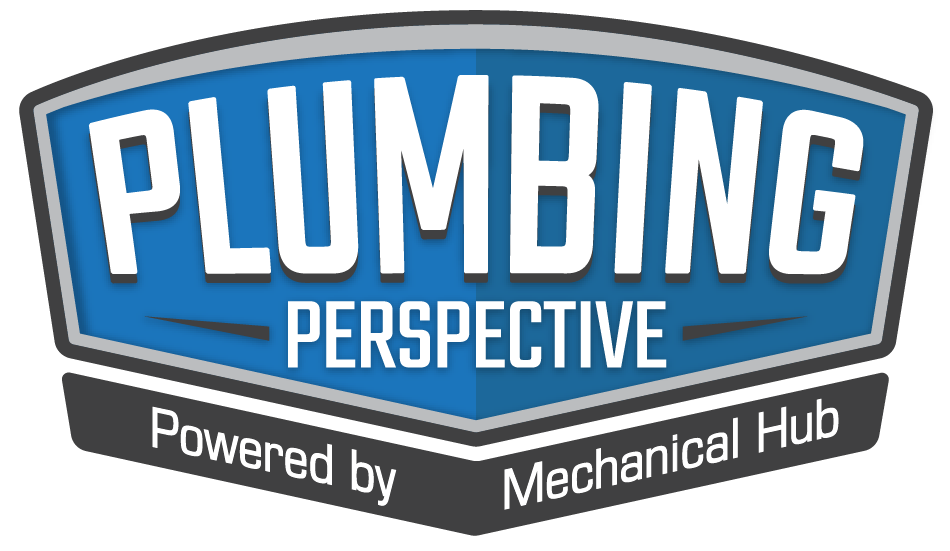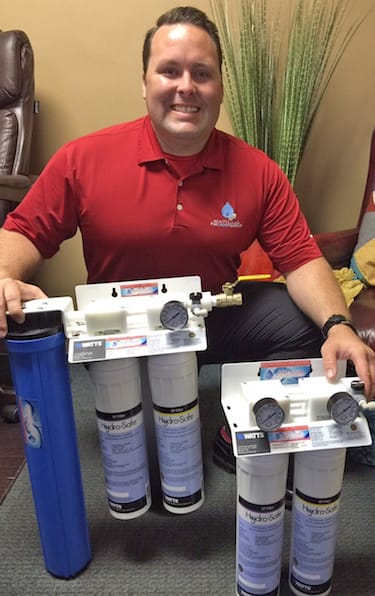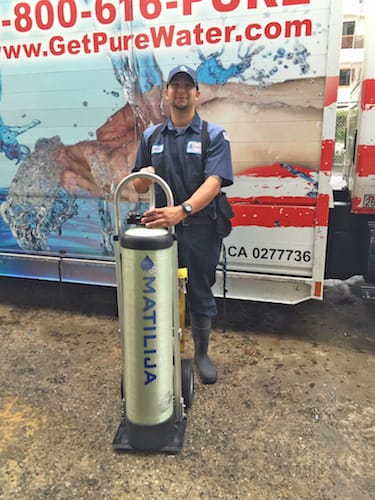As the southwestern drought maintains its white knuckle grip on the central and lower parts of the Golden State, Californians continue to find resourceful ways to trim their water consumption. Businesses large and small are no exception. Seaside resorts—with massive pools, landscape to tend and mountains of laundry to wash—are among the largest water-consuming businesses Read more
Whats New

As the southwestern drought maintains its white knuckle grip on the central and lower parts of the Golden State, Californians continue to find resourceful ways to trim their water consumption. Businesses large and small are no exception.
Seaside resorts—with massive pools, landscape to tend and mountains of laundry to wash—are among the largest water-consuming businesses aside from agriculture.
One famous resort in Santa Barbara is a 360-room ode to SoCal luxury. A guest reclined next to the pool, sipping a 93-point Pinot Noir, might find it easy to put all troublesome thoughts aside. But the resort’s outdated, wasteful water softening system wasn’t nearly as serene.
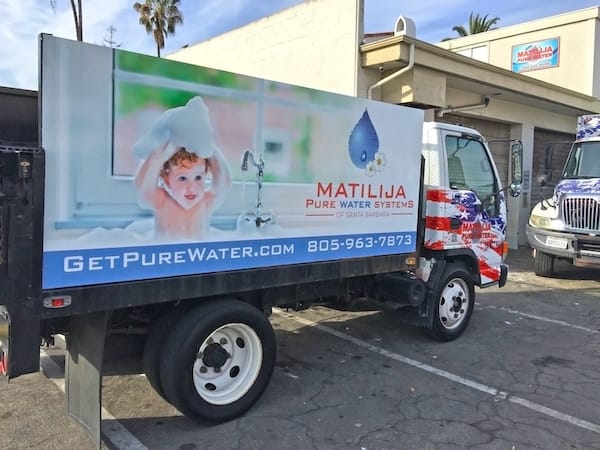
The 10 red, white and blue trucks in the Matilija fleet can be seen in and around Santa Barbara on a daily basis.
Environmental sustainability is something that resort management takes seriously, so late last year they began searching for solutions. With the help of nearby Matilija Pure Water Systems, they’ve recently made water- and salt-saving strides.
“The maintenance department contacted us early in 2015 about replacing the resin in their water softening system,” said Matt Raley, general manager at Matilija. “After visiting the facility, we developed a plan to save water, salt, and maintenance expenses.”
Time for an upgrade
Southern California’s water is hard, anywhere from 25 to 50 grains, and total dissolved solid levels range between 600 to 1,000 PPM. It’s this—along with a more recent emphasis on conservation—that has created high demand for water quality specialists in the Golden State.
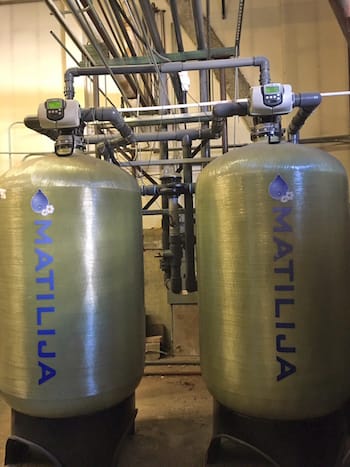
The two alternating, 30-cubic-foot mineral tanks now provide ample, continuous treated water at the resort.
And in Santa Barbara, Matilija Pure Water Systems leads the pack. The nearly-70-year-old firm provides uncompromising water quality service to the greater Santa Barbara area. All of their field staff either hold WQA (Water Quality Association) certification, or are working though the Professional Certification Program. And each technician carries a $500 well water test kit.
As the largest locally-owned water treatment company in the area, Matilija’s 10-truck crew focuses on residential and commercial water filtration, softening and purification. Their technicians maintain the systems they install, right down to scheduled salt deliveries.
The existing, 30-year-old water softening system at the resort included two, 60-cubic-foot mineral tanks. The steel vessels are so large that they were put in place before construction of the facility was compete. Raley wondered if it was worth the expense to replace the media.
After inspection, the answer was a resounding “no.” When the system was installed in 1986, it was generously sized to serve the entire resort. Not long after, plumbing changes across the 24-acre property removed half the load from the big system. Even so, the system wasn’t performing.
“The valves weren’t working correctly, so maintenance personnel were manually regenerating the media tanks,” said Matilija’s Service Manager, Daniel Masse. “And quite often, they had to do it twice, wasting a lot of water, time and salt. That’s a huge expense. We suggested they consider replacing the system instead of re-bedding it.”
Because of its huge volume, replacing the softener media would have been 25% of the cost to replace the entire system.
Fast-paced improvements
Within three weeks of the initial visit, Masse had designed a new system and the project went out to bid. In just a few short weeks, the resort would have a system that cut their salt use in half while actually delivering soft water.
“Ours wasn’t the lowest bid, but we also don’t cut any corners,” said Masse, who’s been with the company since 2010. “For example, I learned that one of the bids reduced the three-inch water lines down to two-inch valves. After we explained why we specified the larger valves, the resort saw the higher value in our proposal.”
In late June, with Masse leading the charge at the resort, a subcontractor was hired for extra manpower on the fast-paced project. With the laundry and main water heaters depending on the water supply, resort management wanted the task completed in a matter days.
“We installed a metered Watts WS3 valve and two alternating, 30-cubic-foot mineral tanks,” continued Raley. “We’re the largest Watts dealer in this area. Over the past 10 or 15 years using the product, we’ve found the support we receive to be outstanding. It’s also a big benefit to work with a manufacturer that makes a component for just about every application we encounter.”
Despite being half the size of the original mineral tanks, it was no walk in the park getting the new units in place. There was no room to install the new system next to the old one, so water lines needed to be piped into the adjacent boiler room. The new tanks were lowered over a handrail and eight feet down into the mechanical space.
A large, three-way bypass valve was installed right away, and new schedule 80 PVC was suspended from ceiling anchors.
“Before the retrofit, the resort was manually-regenerating their tanks, using two pallets of salt each month, and still didn’t have soft water,” said Masse. Now, they’re using half as much salt, water tests indicated zero grains of hardness, and the system regenerates automatically.”
The entire eight-day project was a race against the clock. Hiring the extra help played a key role in the success of the project, and so did familiarity with the products used.
“When we find good products, we stick with them,” said Raley. “We’re not the cheapest source of water quality expertise, but we provide premium service and carry high-end components. We shy away from less expensive water treatment products because we’ve learned they just doesn’t hold up in SoCal.”
Matilija Pure Water Systems’ dedication to superior product and service is apparent. If one look at an installation isn’t convincing enough, the fact that they have between 3,000 and 5,000 reoccurring customers tells the rest of the story. It comes as no surprise that a resort that’s known for an uncompromising guest experience would hire water quality experts with the same reputation.
“Given the option to marginally improve the old water softening system or make great strides to conserve salt and water, the resort management chose to make a real investment in the future,” said Raley. “That says a lot about their commitment to providing the best possible atmosphere for guests, as well as their standpoint on environmental sustainability.”

Flint, Mich. — Mayor Karen Weaver and FAST Start Coordinator Michael C. McDaniel told hundreds of participants attending the Flint Water Infrastructure Summit this week that copper pipe will be used to replace the City of Flint’s entire lead and lead-tainted galvanized iron service lines. “We chose copper because the residents of Flint deserve a Read more
Flint, Mich. — Mayor Karen Weaver and FAST Start Coordinator Michael C. McDaniel told hundreds of participants attending the Flint Water Infrastructure Summit this week that copper pipe will be used to replace the City of Flint’s entire lead and lead-tainted galvanized iron service lines.
“We chose copper because the residents of Flint deserve a high quality engineered material that has a history of safely conveying drinking water,” Weaver said. “With copper, we know we’re getting a long-term solution.”
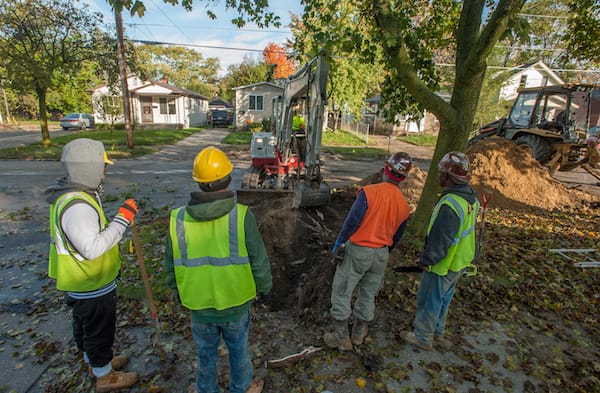
Replacing lead water pipes with copper piping between the street and homes in Flint, Michigan October 28, 2016. (John M. Galloway)
McDaniel said that the decision was made after a number of factors were considered, especially the longevity of the piping and the lifetime cost of the product.
“This was a very important decision that will affect many generations to come,” McDaniel said. “My team and I conducted months of research and engaged in conversation with piping experts regarding the ideal lead replacement material for superior performance.”
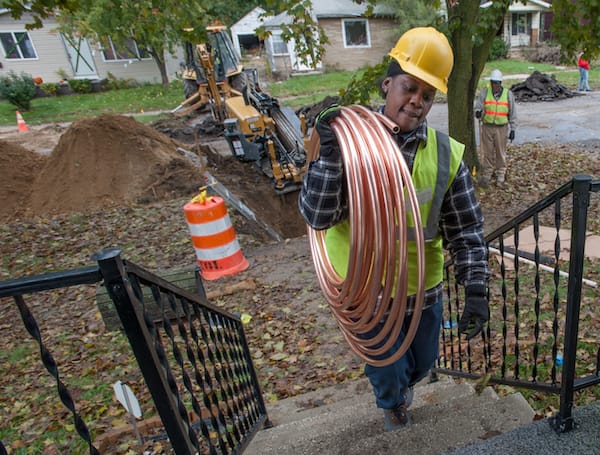
Replacing lead water pipes with copper piping between the street and homes in Flint, Michigan October 28, 2016. (John M. Galloway)
The City concluded that copper was the best material for the replacement pipes because it’s durable, reliable and long-lasting. Copper piping is also impermeable, so outside chemicals such as petroleum products spilled on nearby streets or insecticides and fertilizers spread on yards can’t contaminate the water system.
Following the City’s determination, the copper industry banded together to help Flint acquire nearly 200,000 feet of copper piping, at a savings of approximately $1 million to the City, for the next phase of the FAST Start program, due to start in April.
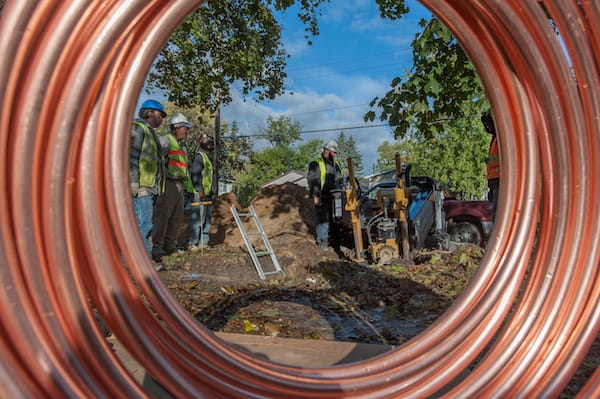
Replacing lead water pipes with copper piping between the street and homes in Flint, Michigan October 28, 2016. (John M. Galloway)
“The copper industry will continue to provide technical guidance and educational resources wherever needed to ensure that copper piping is designed, installed and operated properly every step of the way,” said Andrew G. Kireta, Jr. of the Copper Development Association (CDA). “We are committed to helping America rebuild its aging water infrastructure.”
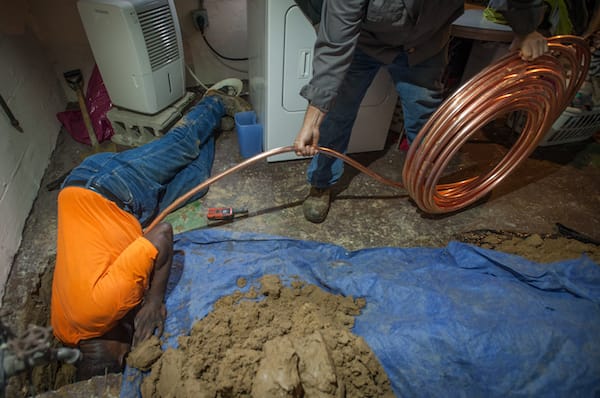
Replacing lead water pipes with copper piping between the street and homes in Flint, Michigan October 28, 2016. (John M. Galloway)
CDA exhibited at the Flint Water Infrastructure Summit and was selected as a speaker for the Water Infrastructure 101 Workshop. Kireta gave two, 20-minute presentations on “Why Copper is the Right Choice” for lead service line replacements and hosted an open forum to interact with attendees on questions related to this topic.
For more information about copper piping, visit www.copperservicelines.org.

Nelson Stark used Viega ProPress® to install the plumbing for the construction of Mercy Health – West Hospital in Cincinnati. Plumbers installed a combination of Viega ProPress for stainless pipe and fittings with Viega ProPress copper fittings as well as transition fittings for potable water at the medical facility. “The project called for 3″ and Read more
Nelson Stark used Viega ProPress® to install the plumbing for the construction of Mercy Health – West Hospital in Cincinnati. Plumbers installed a combination of Viega ProPress for stainless pipe and fittings with Viega ProPress copper fittings as well as transition fittings for potable water at the medical facility.
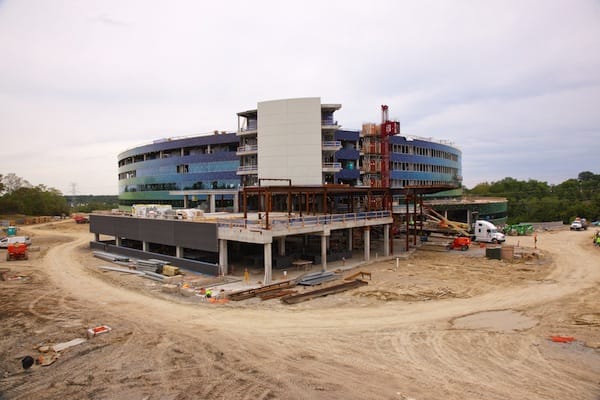 “The project called for 3″ and 4″ mains from the mechanical room, down the halls and up the entire building tower. From the mains into each room we installed copper tubing and fittings in 2″ and smaller,” said Todd Elliot, Project Executive at Nelson Stark.
“The project called for 3″ and 4″ mains from the mechanical room, down the halls and up the entire building tower. From the mains into each room we installed copper tubing and fittings in 2″ and smaller,” said Todd Elliot, Project Executive at Nelson Stark.
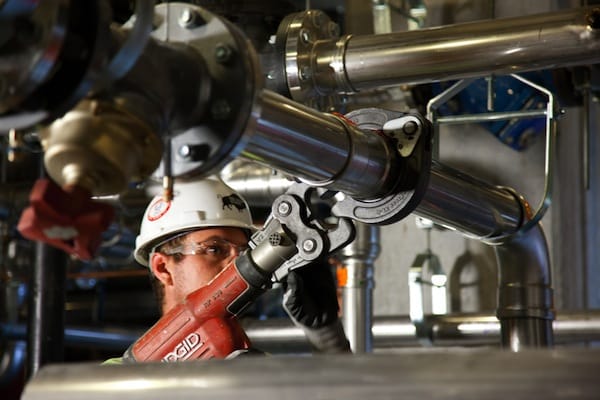 Nelson Stark selected Viega ProPress for the plumbing installation because the system is flameless and can be installed simultaneously with other utilities since there’s no need for welding or grooving equipment. Overall, the plumbing install required more than 3,800ˈ of large-diameter 316 stainless steel pipe and approximately 900 Viega ProPress stainless steel fittings as well as approximately 7,500 Viega ProPress copper fittings and valves.
Nelson Stark selected Viega ProPress for the plumbing installation because the system is flameless and can be installed simultaneously with other utilities since there’s no need for welding or grooving equipment. Overall, the plumbing install required more than 3,800ˈ of large-diameter 316 stainless steel pipe and approximately 900 Viega ProPress stainless steel fittings as well as approximately 7,500 Viega ProPress copper fittings and valves.
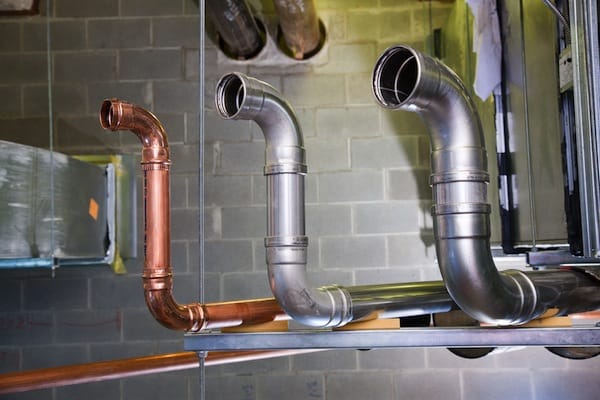 “Our customer saved on costs by having fewer hours of labor and using cost-effective stainless, but they will also save on future maintenance costs by using Viega ProPress because it allows repair work to be completed with little or no shutdown time,” said Mike Wells, Project Superintendent at Nelson Stark.
“Our customer saved on costs by having fewer hours of labor and using cost-effective stainless, but they will also save on future maintenance costs by using Viega ProPress because it allows repair work to be completed with little or no shutdown time,” said Mike Wells, Project Superintendent at Nelson Stark.
Click here to read more.

We often think of a facelift as an external beautification tool, but in the case of a 184-unit Lafayette, LA apartment complex, it’s what we can’t see that needed the biggest makeover. The building’s plumbing system had suffered from leaky pipes for quite some time when the owners decided to replace the outdated polybutylene piping Read more
We often think of a facelift as an external beautification tool, but in the case of a 184-unit Lafayette, LA apartment complex, it’s what we can’t see that needed the biggest makeover. The building’s plumbing system had suffered from leaky pipes for quite some time when the owners decided to replace the outdated polybutylene piping with PEX tubing.
 They hired SageWater, a Virginia-based company specializing in pipe replacements, to complete the job. SageWater, who operates nationwide, has installed over 30 million feet of new pipe in more than 80,000 existing (and occupied) apartments and condominiums across the country over the last few decades.
They hired SageWater, a Virginia-based company specializing in pipe replacements, to complete the job. SageWater, who operates nationwide, has installed over 30 million feet of new pipe in more than 80,000 existing (and occupied) apartments and condominiums across the country over the last few decades.
In order to keep tenants in their apartments during the repipe job, SageWater workers took great care in managing the process to minimize interruptions and ensure comfort. At the end of each workday, affected tenants had the water turned back on in their units and workers removed protective plastic put in place each morning to keep apartments clear of dust and dirt.
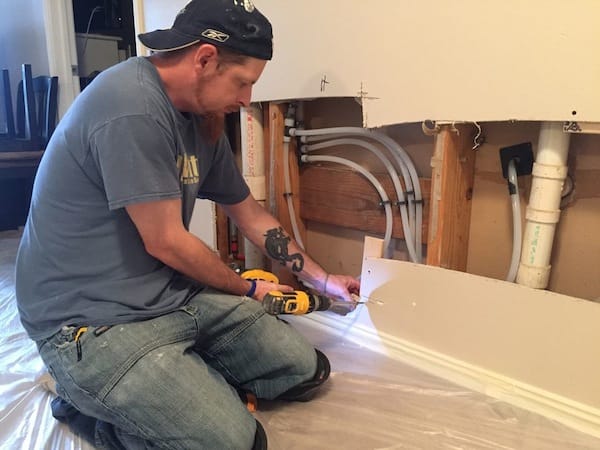 The original pipes were run through the first floor slab of the two-story building, but the replacement pipes were installed through the first floor ceiling. “It’s common to use a different path from the existing pipes to avoid obstacles such as electrical, joist and concrete barriers,” explained SageWater’s Chris Nelson, senior project manager on site.
The original pipes were run through the first floor slab of the two-story building, but the replacement pipes were installed through the first floor ceiling. “It’s common to use a different path from the existing pipes to avoid obstacles such as electrical, joist and concrete barriers,” explained SageWater’s Chris Nelson, senior project manager on site.
And since Uponor offers PEX in long coil lengths, the installers were able to run 300-foot coils versus the 20-foot CPVC maximum lengths, ensuring faster installation times and fewer fittings (thus reducing room for mistakes). “Also, CPVC requires more cuts and therefore more fittings,” Nelson said. He and his crew have worked with PEX over the last several years, but are still impressed with its tight bend radius and the ease of adding ProPEX fittings using the Milwaukee tool. “In my experience, once the fittings are on, they don’t leak or break,” Nelson said, “and PEX is easier and faster to install than any other alternative product out there.”
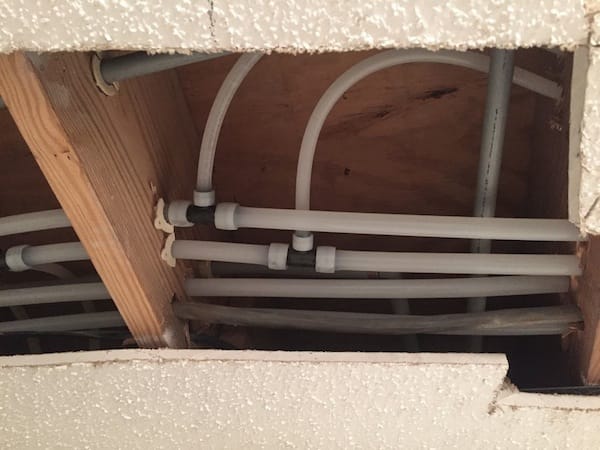
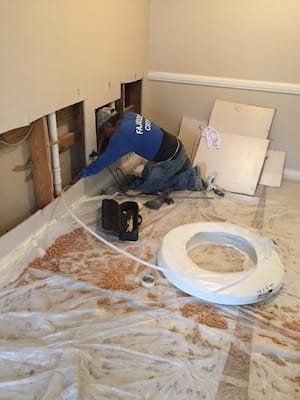
The crew from SageWater provided a turnkey installation with the least amount of disruption to the tenants. It’s a balancing act to work around tenants’ essential comforts and the need to install the new pipe (cutting into ceilings and drywall for access), and then to repair and paint after the completion of work. “We do a lot of repipe jobs,” Nelson said, “and we are comfortable balancing all the elements involved so the job is done quickly, correctly, on time and within budget.”
The project took about five months from start to finish (typically running about two workdays per apartment unit) and six professionals to complete the various jobs needed for a proper and professional installation.
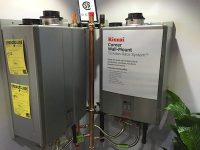
Check this out. Rinnai introduces the Corner Wall-Mount Tankless Rack System. Pretty cool space-saving ideas in a retrofit or small footprint installations. In keeping with Rinnai’s focus on developing streamlined water heating solutions for commercial applications, the company recently introduced its Corner Tankless Rack System, which is designed to be the replacement for medium-to-large Read more
Check this out. Rinnai introduces the Corner Wall-Mount Tankless Rack System. Pretty cool space-saving ideas in a retrofit or small footprint installations.

In keeping with Rinnai’s focus on developing streamlined water heating solutions
for commercial applications, the company recently introduced its Corner Tankless Rack
System, which is designed to be the replacement for medium-to-large tank water heaters.
By allowing two C199 tankless units to be installed on perpendicular walls in the corner of
a room, the Corner Tankless Rack System frees up valuable floor space previously taken
by a tank. The system also features a vertical manifold design, so plumbers can pipe into
existing piping, as well as a wall-hanging bracket, which enables time and materials to be
saved during quick replacements.
“The Corner Tankless Rack System makes replacing an existing commercial tank with two C199 tankless units simpler than ever before,“ said Houston. “With it’s wall-mount design and zero floor footprint, the unit is ideal for applications where space is at a premium, like restaurants, laundries, school or hotel kitchens and breweries. Since launching this past fall, we’ve seen a great response from installers, and it has been more popular than even we anticipated.”
